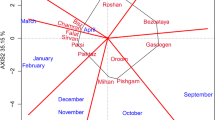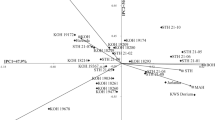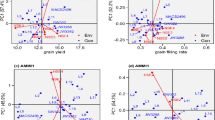Abstract
Understanding the genetic and environmental causes of genotype-by-environment (GE) interaction for grain yield is of fundamental importance in plant breeding. This study aimed at investigating the GE interaction and the stability of durum wheat (Tritium turgidum L. ssp. durum) genotypes evaluated for grain yield across different locations and years, using empirical and analytical models. The study used 19 genotypes in 14 environments, representative of rainfed durum wheat-growing areas. The genotype main effect plus GE interaction (GGE) biplot model, partial least squares regression and factorial regression models were applied for data analysis. The combined ANOVA revealed significant genotype, environment and GE interaction effects, with the environmental main effect as a main source of variation (77.9% of total variation). The mean yield of the genotypes ranged from 486 to 5594 kg/ha across environments. Using GGE biplot analysis, the test environments were classified into four groups, each with different winning genotypes. Based on mean yield and stability performance across environments, breeding lines G17 and G15 significantly out-yielded the best national check and could be recommended for release as new varieties. Rainfalls in March, June, November and May, average temperatures in June and May, heading date and 1000-kernel weight were among the explanatory covariates that significantly (P < 0.01) affected the GE interaction for grain yield.



Similar content being viewed by others
References
Annicchiarico P (2002) Genotype x environment interactions: challenges and opportunities for plant breeding and cultivar recommendations. Food and Agriculture Organisation, Rome, Italy
Babić V, Babić M, Ivanović M, Filipović M (2011) Pattern in interaction in the maize yield trial. J Agric Sci 56(2):101–110
Beres BL, Rahmani E, Clarke JM, Grassini P, Pozniak CJ, Geddes CM, Porker KD, May WE, Ransom JK (2020) A systematic review of durum wheat: enhancing production systems by exploring genotype, environment, and management (G × E × M) synergies. Front Plant Sci 11:568657
Chairi F, Aparicio N, Serret MD, Araus JL (2020) Breeding effects on the genotype × environment interaction for yield of durum wheat grown after the green revolution: the case of Spain. Crop J 8:623–634
De Vita P, Maggio A (2006) Yield stability analysis in durum wheat: progress over the last two decades in Italy. Cereal Res Commun 34:1207–1214
De Vita P, Mastrangelo AM, Matteu L, Mazzucotelli E, Virzi N, Palumbo M, Storto ML, Rizza F, Cattivelli L (2010) Genetic improvement effects on yield stability in durum wheat genotypes grown in Italy. Field Crops Res 119:68–77
Denis JB (1988) Two-way analysis using covariates. Statistics 19:123–132
Garcia del Moral LF, Rharrabti Y, Elhani S, Martos V, Royo C (2005) Yield formation in Mediterranean durum wheats under two contrasting water regimes based on path-coefficient analysis. Euphytica 146:203–212
González-Ribot G, Opazo M, Silva P, Acevedo E (2017) Traits explaining durum wheat (Triticum turgidum L. spp. durum) yield in dry chilean mediterranean environments. Front Plant Sci 8:1781
Mahrookashani A, Siebert S, Huging H, Ewert F (2017) Independent and combined effects of high temperature and drought stress around anthesis on wheat. J Agron Crop Sci 203:453–463
Mohammadi R (2016) Efficiency of yield-based drought tolerance indices to identify tolerant genotypes in durum wheat. Euphytica 211:71–89
Mohammadi R, Armion M, Sadeghzadeh D, Amri A, Nachit M (2011) Analysis of genotype-by-environment interaction for agronomic traits of durum wheat in Iran. Plant Prod Sci 14(1):15–21
Mohammadi R, Armion M, Zadhasan E, Ahmadi MM, Amri A (2018) The use of AMMI model for interpreting genotype x environment interaction in durum wheat. Exp Agric 54:670–683
Mohammadi R, Haghparast R, Amri A, Ceccarelli S (2010) Yield stability of rainfed durum wheat and GGE biplot analysis of multi-environment trials. Crop Pas Sci 61:92–101
Nzuve F, Githiri S, Mukunya D, Gethi J (2013) Analysis of genotype x environment interaction for grain yield in maize hybrids. J Agric Sci 5:75
Ortiz R, Crossa J, Vargas M, Izquierdo J (2007) Studying the effect of environmental variables on the genotype × environment interaction of tomato. Euphytica 153:119–134
Pacheco A, Vargas M, Alvarado G, Rodríguez F, Crossa J, Burgueño J (2016) GEA-R (genotype x environment analysis with R for windows), Version 2.0. Mexico: CIMMYT. Retrieved from http://hdl.handle.net/11529/10203
Pandey GC, Mehta G, Sharma P, Sharma V (2019) Terminal heat tolerance in wheat: an overview. J Cer Res 11:1–16
Putto W, Patanothai A, Jogloy S, Hoogenboom G (2008) Determination of mega-environments for peanut breeding using the CSMCROPGRO-peanut model. Crop Sci 48:973–982
Royo C, Dreisigacker S, Ammar K, Villegas D (2020) Agronomic performance of durum wheat landraces and modern cultivars and its association with genotypic variation in vernalization response (Vrn-1) and photoperiod sensitivity (Ppd-1) genes. Eur J Agron 120:126129
Shirdelmoghanloo H, Cozzolino D, Lohraseb I, Collins NC (2016) Truncation of grain filling in wheat (Triticum aestivum) triggered by brief heat stress during early grain filling: association with senescence responses and reductions in stem reserves. Funct Plant Biol 43(10):919–930
Stojaković M, Mitrović B, Zorić M et al (2015) Grouping pattern of maize test locations and its impact on hybrid zoning. Euphytica 204:419–431
Subira J, Alvaro F, García del Moral LF, Royo C (2015) Breeding effects on the cultivar × environment interaction of durum wheat yield. Eur J Agron 68:78–88
Van Eeuwijk FA, Denis JB, Kang MS (1996) Incorporating additional information on genotypes and environments in models for two-way genotype by environment tables. In: Kang MS, Gauch HG (eds) Genotype-by-environment interaction. CRC Press, Boca Raton
Vargas M, Crossa J, van Eeuwijk FA, Sayre K, Reynolds MP (2001) Interpreting treatment × environment interaction in agronomy trials. Agron J 93:949–960
Yan W (2001) GGE biplot-A windows application for graphical analysis of multi-environment trial data and other types of two-way data. Agron J 93:1111–1118
Yan W (2014) Crop variety trials: data management and analysis. Wiley-Blackwell, New York
Yan W, Tinker NA (2006) Biplot analysis of multi-environment trial data: Principles and applications. Can J Plant Sci 86:623–645
Acknowledgements
This research (Grant Code: 0-15-15-072-961355) was funded by Dryland Agriculture Research Institute (DARI) of Iran. The authors thank the two reviewers and the editor of Agricultural Research for providing helpful comments and corrections on this manuscript.
Author information
Authors and Affiliations
Contributions
RM conceptualized the experiment and designed the methodology. RM, JJ, MMP and HH performed the field evaluations and recorded data. RM performed the data analysis, software implementation and visualization and wrote the original manuscript. AA contributed to the interpretation of results and revision of the manuscript. All the authors have read and approved the final manuscript.
Corresponding author
Ethics declarations
Conflict of interest
The authors declare that they have no conflicts of interest.
Additional information
Publisher's Note
Springer Nature remains neutral with regard to jurisdictional claims in published maps and institutional affiliations.
Supplementary Information
Below is the link to the electronic supplementary material.
Rights and permissions
Springer Nature or its licensor (e.g. a society or other partner) holds exclusive rights to this article under a publishing agreement with the author(s) or other rightsholder(s); author self-archiving of the accepted manuscript version of this article is solely governed by the terms of such publishing agreement and applicable law.
About this article
Cite this article
Mohammadi, R., Jafarzadeh, J., Poursiahbidi, M.M. et al. Genotype-by-Environment Interaction and Stability Analysis for Grain Yield in Durum Wheat Using GGE Biplot and Genotypic and Environmental Covariates. Agric Res 12, 364–374 (2023). https://doi.org/10.1007/s40003-023-00661-y
Received:
Accepted:
Published:
Issue Date:
DOI: https://doi.org/10.1007/s40003-023-00661-y




